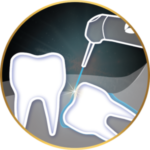
Periodontal treatment
Do you clean your teeth the right way? Brushing mistakes will, in the long run, lead to plaque buildup, or the buildup of tartar between the teeth and the gums, resulting in loose teeth, wider gaps between teeth, receding gums, toothaches and other symptoms of gum disease, which will become increasingly serious if left ignored.
As gum disease and tooth decay might not both be present in the patient’s oral cavity at the same time, many patients tend to overlook the existence of gum disease, with the misconception that their teeth and gums are normal and healthy in the absence of cavities. As such, they may miss the opportune period for treating gum disease, and tragically, have to deal with tooth loss from severe gum disease.
Do you clean your teeth the right way? Brushing mistakes will, in the long run, lead to plaque buildup, or the buildup of tartar between the teeth and the gums, resulting in loose teeth, wider gaps between teeth, receding gums, toothaches and other symptoms of gum disease, which will become increasingly serious if left ignored.
As gum disease and tooth decay might not both be present in the patient’s oral cavity at the same time, many patients tend to overlook the existence of gum disease, with the misconception that their teeth and gums are normal and healthy in the absence of cavities. As such, they may miss the opportune period for treating gum disease, and tragically, have to deal with tooth loss from severe gum disease.
【Gum Disease Symptoms】
Gum disease is a general term for periodontal diseases, such as periodontitis and gingivitis, which are chronic diseases in the oral cavity. While the symptoms of periodontitis and gingivitis may differ, they both pertain to the periodontal tissue and are thus collectively referred to as gum or periodontal disease.
Like many chronic diseases, the initial symptoms of gum disease are not immediately obvious and it is often painless. Sometimes, there the gums may gradually become red and swollen or there may be bad breath, but these symptoms are often ignored.
When the above symptoms of gum disease are present, further treatment is required to prevent irreparable harm. The development of gum disease is a lengthy process, stretching from the initial symptom of bleeding gums when brushing, to the mid-stage symptoms of gum boils, bad breath, and receding gums, to loose teeth in the advanced-stage of gum disease.

【Causes of Gum Disease】
The main culprit behind gum disease is bacteria. The bacteria attach themselves to the teeth, gradually calcifying particles into tartar while producing toxins that attack the periodontal tissue, eventually leading to tooth loss.
Gum disease gradually worsens over time, but in some special cases such as in smokers and those with fibrotic gingiva, symptoms of bleeding or swollen gums may not be present. As such, one cannot simply rely on the naked eye to identify gum disease. Instead, you should get a professional dentist to do a thorough examination of your gums regularly. It is crucial that you work together with your dentist to fight gum disease!
The main culprit behind gum disease is bacteria. The bacteria attach themselves to the teeth, gradually calcifying particles into tartar while producing toxins that attack the periodontal tissue, eventually leading to tooth loss.
Gum disease gradually worsens over time, but in some special cases such as in smokers and those with fibrotic gingiva, symptoms of bleeding or swollen gums may not be present. As such, one cannot simply rely on the naked eye to identify gum disease. Instead, you should get a professional dentist to do a thorough examination of your gums regularly. It is crucial that you work together with your dentist to fight gum disease!
【Self-Examination for Gum Disease: 8 Common Symptoms】

• Bleeding gums when brushing your teeth
• Toothache, swollen gums, or dark red gums
• Gums do not fit snugly against the teeth, forming gingiva grooves
• An unpleasant odor in the mouth (bad breath)
• Pus between the gums and the teeth
• Tooth mobility or loose teeth
• A strange sensation when the upper and lower teeth are clenched together
• When your removable dentures suddenly do not fit your mouth well
【Treatment of Gum Disease】
To treat gum disease, tartar and plaque is first removed from the gums and teeth, and the inflammation is treated with drugs to keep the loose teeth in place. Next, the dentist comes up with a plan based on the patient’s condition. If there are missing teeth, dentures or dental implants will become part of the treatment. In general, the treatment of gum disease takes several months, during which the patient has to do their part and exercise good oral hygiene, as well as cultivate good habits to avoid future reoccurrence. The severity of gum disease might differ between patients, and it helps to clarify whether gum disease treatment is covered by the national health insurance or must be paid out of pocket when booking a consultation. This is to prevent any disputes between the two parties about the treatment cost from arising.
To treat gum disease, tartar and plaque is first removed from the gums and teeth, and the inflammation is treated with drugs to keep the loose teeth in place. Next, the dentist comes up with a plan based on the patient’s condition. If there are missing teeth, dentures or dental implants will become part of the treatment. In general, the treatment of gum disease takes several months, during which the patient has to do their part and exercise good oral hygiene, as well as cultivate good habits to avoid future reoccurrence. The severity of gum disease might differ between patients, and it helps to clarify whether gum disease treatment is covered by the national health insurance or must be paid out of pocket when booking a consultation. This is to prevent any disputes between the two parties about the treatment cost from arising.
【Periodontal treatment assisted
with Waterlase dentistry】
What dental procedures can Waterlase dentistry help with?
Dental Implants

- Smaller wounds, less bleeding
- Less swelling and lower chance of infection
- Treating peri-implantitis without damaging the implant surface
- Effectively sterilizing the area
Periodontal
Treatment

- Effective root surface debridement and sterilization
- Efficient removal of plaque – more efficient than traditional methods
- Reducing postoperative swelling and pain
- Effective removal of tartar
Pediatric Dentistry

- No high frequency vibration and shrill sound, helping to eliminate children’s anxiety
- Efficient cleaning and sterilization of crevices to prevent tooth decay
Root Canal Treatment

- Effective cleaning of the root canal and reducing postoperative inflammation
- Physically removing stains by laser technology while sterilizing the canal
Dental Restoration

- Removal of caries and pigmentation spots
- Avoiding red and swollen gums
Aesthetic Dentistry

- Gum depigmentation
- Contouring the gum to improve your smile
Tooth Extraction

- Helping to stop bleeding
- Effective sterilization
- Prevention of postoperative infection
【Gum Disease Treatment Procedure】
STEP 1
STEP 2
STEP 3
STEP 4
STEP 5



(First stage)
▪Tartar removal: Also known as teeth cleaning, tartar is removed around the gums through ultrasonic scaling. The scaler head vibrates against the surface of the tooth to remove tartar and bacteria.
▪Root planing: This is mainly aimed at removing the dental plaque on the surface of the root and cleaning the dentin contaminated by bacteria.
(Second stage)
In this stage of gum disease, the periodontal tissue has been damaged. The following procedures can be used to restore the teeth.
▪Regenerative periodontal therapy: Artificial bone meal, animal bone meal or synthetic materials are used to repair the alveolar bone and restore the basic function of the teeth.
▪Periodontal flap surgery: An incision is made in the gum to remove the highly inflamed tissue and tartar.
“Periodontal surgeries are day surgeries, and life goes back to normal the next day. It is recommended that regular visits be made after periodontal surgery at three-to-six-month intervals for the maintenance of your teeth.”
(Third stage)
In the advanced stage of gum disease, there may be loose teeth or your teeth that may have been severely eroded and irreparably damaged, which means that the teeth may have to be extracted. To avoid your teeth deteriorating to this stage, it is recommended that you go for teeth cleaning regularly.
(First stage)
▪Tartar removal: Also known as teeth cleaning, tartar is removed around the gums through ultrasonic scaling. The scaler head vibrates against the surface of the tooth to remove tartar and bacteria.
▪ Root planing: This is mainly aimed at removing the dental plaque on the surface of the root and cleaning the dentin contaminated by bacteria.

(Second stage)
▪ In this stage of gum disease, the periodontal tissue has been damaged. The following procedures can be used to restore the teeth.
▪Regenerative periodontal therapy: Artificial bone meal, animal bone meal or synthetic materials are used to repair the alveolar bone and restore the basic function of the teeth.
▪Periodontal flap surgery: An incision is made in the gum to remove the highly inflamed tissue and tartar.
“Periodontal surgeries are day surgeries, and life goes back to normal the next day. It is recommended that regular visits be made after periodontal surgery at three-to-six-month intervals for the maintenance of your teeth.”

(Third stage)
【Periodontal Treatment Q&A】
Q.Can gum disease be cured?
Q.Is gum disease contagious?
Q.How does one prevent gum disease?
A. Method 1: Use the Bayesian method to brush your teeth. Method 2: Floss your teeth. Method 3: Get examined for gum disease regularly and avoid bad habits.
▸( Click here for more periodontal surgery precautions )
Q.o I need to take leave from work for periodontal surgery?
Q.How much do gum disease treatments cost?
Q.Is tartar a sign of gum disease?
Q.Is periodontal surgery painful?
Q.How is gum disease treated?





